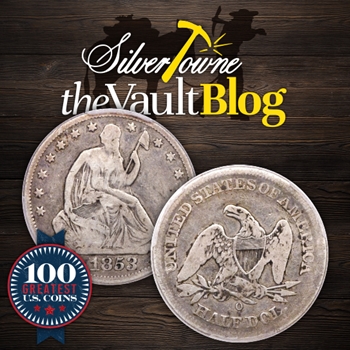
You hear it all the time in not just the coin collecting hobby but any collecting hobby really, “it is rare.” A number of circumstances could present an item as such and there is no doubt that some are created and some just occur. More times than not, however, when it comes to the numismatic business, naturally occurring events are what make coins and currency rare and that is especially true about our next entry in this blog series.
Brought on by a Coinage Act and no doubt human error, author Jeff Garrett takes us through the fourth edition publication of the 100 Greatest United States Coins and lands on a half dollar that was said to have a mintage of zero. Alongside Ron Guth, Garrett explains the difference between “common” and “rare” and features the Christian Gobrecht designed half dollar as one of the most important rarities out there.
#82 - 1853-O “No Arrows” Liberty Seated Half Dollar
The Coinage Act of 1853 put into motion this especially rare Liberty Seated half dollar. The Act would look to change the weight of the half dollar from 13.35 grams to 12.44 grams. To help the public decipher the difference between the new coins and the old, they made a design change that would place arrowheads on both sides of the date on the obverse and rays around the eagle depicted on the reverse. Because the old coins were heavier, they ended up being worth more than their face value which in turn caused the government to melt down millions of them and use the silver composition to make the new, lighter-weight coins. Thus, any surviving half Liberty Seated half dollar preceding the 1853 date would most likely be the result of a collector or hoarder holding onto it. The author also makes note that “plain luck” would, in addition, be a reason for the survival of the coins.
Continuing on in the circumstances to cause such a rarity, we now look to late 1852, early 1853 when the New Orleans Mint would receive dies from the Philadelphia Mint to start preparing for the next year’s coinage. This happened as it did every year, but some of these dies, in particular, did not feature the design changes of the added arrows and rays. As a result, it is most likely that the New Orleans Mint struck a number of 1853-O half dollars prior to the Coinage Act taking effect. All the coins struck without the changes were said to have been melted...or so they thought. Mint records would reflect that none were struck. But regardless of what is recorded, there is no doubt that some exist.
Designed by the third Chief Engraver of the United States, Christian Gobrecht, there are said to be only three in existence. In 1960, the coin was valued at $3,500 in a Fine condition. Through the years and up until the fourth edition of this publication was published in 2015, that same coin is valued at $300,000.







